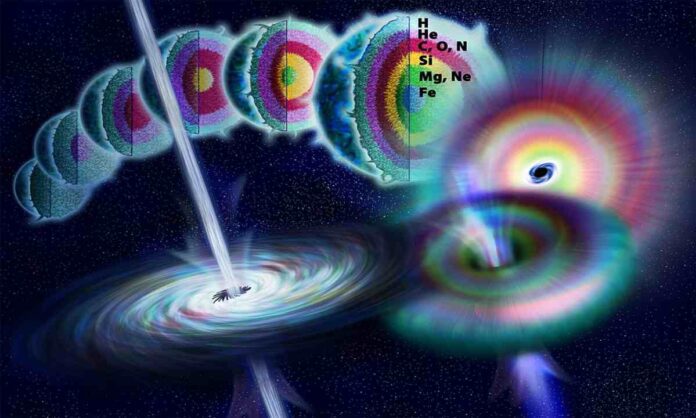A recent discovery of a Gamma-ray burst (GRB) named GRB 220627A has left astronomers puzzled. GRBs are the most powerful explosions in the universe since the Big Bang, and typically last only seconds to a few minutes. However, GRB 220627A lasted for more than a thousand seconds, or just shy of 17 minutes, and arrived in two powerful bursts from an unknown event 2 billion years into the universe’s existence.
While the source of the burst appears to be ordinary, its length and double-burst nature have left astronomers puzzled. The likeliest explanation is that the GRB is the product of gravitational lensing, which is the warping of distant light sources by extremely massive objects such as galaxies and black holes. This would stretch, distort, and create echoes of the GRB’s signal before it arrived at Earth.
When a massive star runs out of fuel, it collapses before exploding outward in a gigantic supernova, leaving behind an ultra-dense neutron star or a black hole. It is these stellar explosions —and occasionally even collisions between two neutron stars — that produce powerful bursts of gamma rays that can be picked up by space observatories such as NASA’s Fermi Gamma-ray Space Telescope, which detected the new GRB.
To investigate the strange signal, astronomers studied its afterglow — the fainter and less energy-intense light created by GRBs when shock waves from the initial explosion slam into gas and dust surrounding the burst star. Yet the GRB’s afterglow only deepened the mystery: Unlike the long duration of the burst it came from, the afterglow was entirely normal, appearing much like those produced by regular, minutes-long GRBs.
“Our observations and modeling of GRB 220627A do not suggest that a different progenitor compared to the progenitor of normal long GRBs is required,” the researchers wrote in their paper.
It’s possible that the presence of a gigantic black hole or galaxy between us and the GRB’s source is lengthening as well as duplicating its signal. However, to be more certain, astronomers will need to characterize the strange signal in better detail, which will require more study and the detection of other stretched-out gamma-ray mirages. The researchers published their findings on July 19 on the database arXiv and are yet to be peer-reviewed.
Gravitational lensing was first predicted by Einstein’s theory of general relativity in 1915. It is a fascinating phenomenon that has been observed many times by astronomers. If this explanation for GRB 220627A is correct, it would be another example of how our understanding of gravity and space-time continues to evolve.
Reference:
S. de Wet, et. al, The ultra-long GRB 220627A at z=3.08, arXiv:2307.10339 (astro-ph), DOI: 10.48550/arXiv.2307.10339
